
Yerkes Observatory is an astronomical observatory located in Williams Bay, Wisconsin, United States. The observatory was operated by the University of Chicago Department of Astronomy and Astrophysics from its founding in 1897 until 2018. Ownership was transferred to the non-profit Yerkes Future Foundation (YFF) in May 2020, which began millions of dollars of restoration and renovation of the historic building and grounds. Yerkes re-opened for public tours and programming in May, 2022. The April, 2024 issue of National Geographic magazine featured a story about the Observatory and ongoing work to restore it to relevance for astronomy, public science engagement and exploring big ideas through art, science, culture and landscape. The observatory offers tickets to programs and tours on its website.

The Mount Wilson Observatory (MWO) is an astronomical observatory in Los Angeles County, California, United States. The MWO is located on Mount Wilson, a 5,710-foot (1,740-meter) peak in the San Gabriel Mountains near Pasadena, northeast of Los Angeles.

The Paris Observatory, a research institution of the Paris Sciences et Lettres University, is the foremost astronomical observatory of France, and one of the largest astronomical centers in the world. Its historic building is on the Left Bank of the Seine in central Paris, but most of the staff work on a satellite campus in Meudon, a suburb southwest of Paris.

The Anglo-Australian Telescope (AAT) is a 3.9-metre equatorially mounted telescope operated by the Australian Astronomical Observatory and situated at the Siding Spring Observatory, Australia, at an altitude of a little over 1,100 m. In 2009, the telescope was ranked as having the fifth-highest-impact of the world's optical telescopes. In 2001–2003, it was considered the most scientifically productive 4-metre-class optical telescope in the world based on scientific publications using data from the telescope.
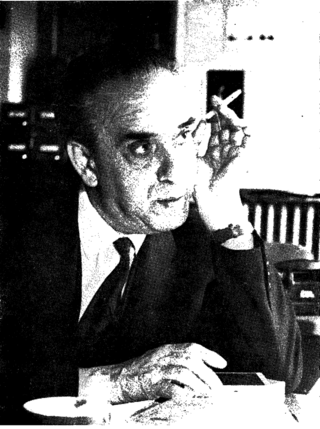
Jean-Henri Focas was a Greek-French astronomer, painter, designer, illustrator, astrophysicists, photographer, and celestial cartographer who spoke five languages. He performed visual studies of planetary surfaces from the National Observatory of Athens, Pic du Midi, and Meudon Great Refractor. Jean is responsible for creating the most highly visual map of Mars ever created by a visual observer of the planet. He developed special photographic equipment to photograph celestial phenomena. In 1961, he published Étude Photométrique et Polarimétrique des Phénomènes Saisonniers de la Planéte Mar which became a classic on the subject of polarimetric investigation of Mars. A crater on the Moon and a crater on Mars were named after him because of his contribution to the field.

The Haute-Provence Observatory is an astronomical observatory in the southeast of France, about 90 km east of Avignon and 100 km north of Marseille. It was established in 1937 as a national facility for French astronomers. Astronomical observations began in 1943 using the 1.20 m telescope, and the first research papers based on observations made at the observatory were published in 1944. Foreign observers first used the observatory in 1949, when Geoffrey and Margaret Burbidge visited.

Paranal Observatory is an astronomical observatory operated by the European Southern Observatory (ESO). It is located in the Atacama Desert of Northern Chile on Cerro Paranal at 2,635 m (8,645 ft) altitude, 120 km (70 mi) south of Antofagasta. By total light-collecting area, it is the largest optical-infrared observatory in the Southern Hemisphere; worldwide, it is second to the Mauna Kea Observatory on Hawaii.

Teide Observatory, IAU code 954, is an astronomical observatory on Mount Teide at 2,390 metres (7,840 ft), located on Tenerife, Spain. It has been operated by the Instituto de Astrofísica de Canarias since its inauguration in 1964. It became one of the first major international observatories, attracting telescopes from different countries around the world because of the good astronomical seeing conditions. Later, the emphasis for optical telescopes shifted more towards Roque de los Muchachos Observatory on La Palma.
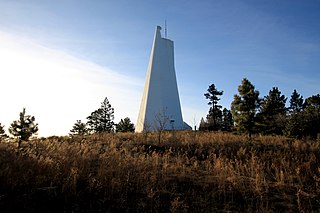
The Dunn Solar Telescope also known as the Richard B. Dunn Solar Telescope is a unique vertical-axis solar telescope, in Sunspot, New Mexico located at Sacramento Peak, New Mexico. It is the main telescope at the Sunspot Solar Observatory, operated by New Mexico State University in partnership with the National Solar Observatory through funding by the National Science Foundation, the state of New Mexico and private funds from other partners. The Dunn Solar Telescope specializes in high-resolution imaging and spectroscopy to help astrophysicists worldwide obtain a better understanding of how the Sun affects the Earth. Completed in 1969, it was upgraded with high-order adaptive optics in 2004 and remains a highly versatile astrophysical observatory that serves as an important test platform for developing new instrumentation and technologies. The Dunn Solar Telescope, located in Sunspot, New Mexico, is a vertical-axis solar telescope that specializes in high-resolution imaging and spectroscopy. It was completed in 1969 and received a significant upgrade with high-order adaptive optics in 2004.
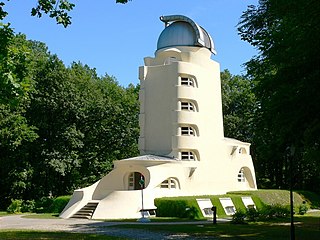
The Einstein Tower is an astrophysical observatory in the Albert Einstein Science Park in Potsdam, Germany built by architect Erich Mendelsohn. It was built on the summit of the Potsdam Telegraphenberg to house a solar telescope designed by the astronomer Erwin Finlay-Freundlich. The telescope supports experiments and observations to validate Albert Einstein's relativity theory. The building was first conceived around 1917, built from 1919 to 1921 after a fund-raising drive, and became operational in 1924. Although Einstein never worked there, he supported the construction and operation of the telescope. It is still a working solar observatory today as part of the Leibniz Institute for Astrophysics Potsdam. Light from the telescope is directed down through the shaft to the basement where the instruments and laboratory are located. There were more than half a dozen telescopes in the laboratory.

A solar telescope or a solar observatory is a special-purpose telescope used to observe the Sun. Solar telescopes usually detect light with wavelengths in, or not far outside, the visible spectrum. Obsolete names for Sun telescopes include heliograph and photoheliograph.

The Great Paris Exhibition Telescope of 1900, with an objective lens of 1.25 m (49 in) in diameter, was the largest refracting telescope ever constructed. It was built as the centerpiece of the Paris Universal Exhibition of 1900. Its construction was instigated in 1892 by François Deloncle (1856–1922), a member of the French Chambre des Députés. Since it was built for exhibit purposes within a large metropolis, and its design made it difficult to aim at astronomical objects, it was not suited for scientific use. When the year-long exposition was over, its builders were unable to sell it. It was ultimately broken up for scrap; the lenses are still stored away at the Paris Observatory.

J A Jones Hoober Observatory is a privately owned observatory located in South Yorkshire, England near to the villages of Hoober and Wentworth, 4 miles (6.4 km) North-northwest of Rotherham. It can be found about 300 metres (0.19 mi) east of Hoober Stand. The observatory is owned and operated by Mexborough & Swinton Astronomical Society (NPO).

Iso-Heikkilä Observatory is an amateur astronomical observatory used by a local amateur astronomical association, Turun Ursa ry in the Iso-Heikkilä district of Turku, Finland.
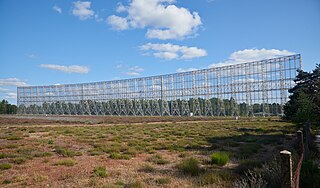
The Nançay Radio Observatory, opened in 1956, is part of Paris Observatory, and also associated with the University of Orléans. It is located in the department of Cher in the Sologne region of France. The station consists of several instruments. Most iconic of these is the large decimetric radio telescope, which is one of the largest radio telescopes in the world. Long established are also the radio heliograph, a T-shaped array, and the decametric array operating at wavelengths between 3 m and 30 m.
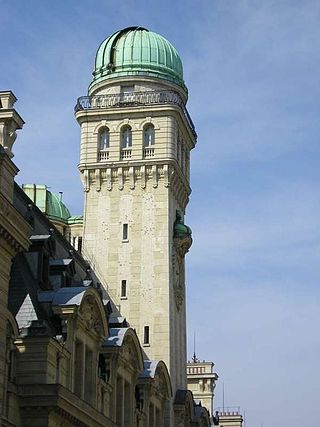
The Astronomy Tower of the Sorbonne is a tower at the Sorbonne University's Paris campus built to house an astronomical observatory for its students. The structure was erected during the reconstruction of the Sorbonne, between 1885 and 1901. The tower is 39 meters high, has an upper and lower dome, and includes several rooms. The upper dome houses the telescope, and the lower dome contains an optics workshop for amateurs to make mirrors. The tower is operated by the Société astronomique de France and is available for tours and amateur observations.

The Observatory of the rue Serpente was an astronomical observatory owned and operated by the Société Astronomique de France in the historic Latin Quarter of Paris. It operated between 1890 until 1968, when it was transferred to a new location at the nearby Astronomy Tower of the Sorbonne.

Meudon Great Refractor is a double telescope with lenses, in Meudon, France. It is a twin refracting telescope built in 1891, with one visual and one photographic, on a single square-tube together on an equatorial mount, inside a dome. The Refractor was built for the Meudon Observatory, and is the largest double doublet refracting telescope in Europe, but about the same size as several telescopes in this period, when this style of telescope was popular. Other large telescopes of a similar type include the James Lick telescope (91.4), Potsdam Great Refractor (80+50 cm), and the Greenwich 28 inch refractor (71.1 cm).

Arago telescope is a 38 cm aperture refracting telescope at Paris Observatory, installed in 1857. Francois Arago ordered this telescope from the telescope making firm Lebreours in 1839, and after a protracted development was completed by 1855. The name Lunette Arago is a modern name for the telescope, and other large refractor of Paris observatory, is the one at Meudon. It has gone by a variety of names having to do with various aspects of the telescope, such as its aperture, or location on the East tower of the Paris observatory, or its equatorial mount made by Brunner. In one journal report it was called the 'east equatorial' for example, in another instance '38 cm refractor'. In French language it has been called the La lunette équatoriale de 38 cm de l'Observatoire de Paris.




















